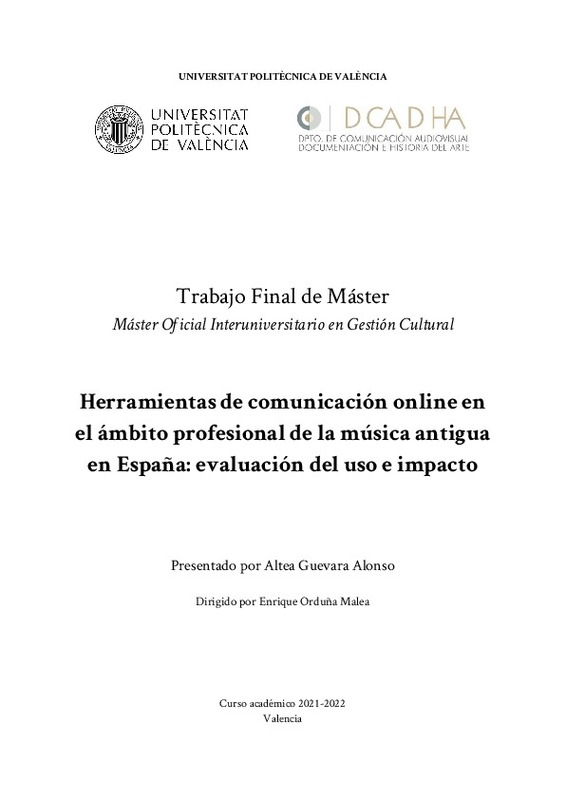|
Resumen:
|
[ES] El presente trabajo de fin de máster pretende contribuir al terreno académico del marketing cultural y digital aplicados a la música clásica, más concretamente a la música antigua, siendo ésta una rama cuyo desarrollo ...[+]
[ES] El presente trabajo de fin de máster pretende contribuir al terreno académico del marketing cultural y digital aplicados a la música clásica, más concretamente a la música antigua, siendo ésta una rama cuyo desarrollo se encuentra en estadios muy iniciales. A tal fin, se analizan las estrategias de comunicación digital que están siendo llevadas a cabo por los principales agentes del sector de la música antigua en el territorio español, discriminando entre tres categorías (intérpretes, ensembles y festivales) para evaluar su grado de desarrollo y adecuación a las dinámicas de consumo actuales. Se utilizan complementariamente tres técnicas: una entrevista a cinco profesionales del sector, una encuesta a 192 personas y un análisis webmétrico (medición de tamaño, visibilidad e impacto web) de 95 sitios web del sector, llevando a cabo una triangulación metodológica que aspira a proporcionar una visión holística del fenómeno bajo estudio al combinar datos cuantitativos y cualitativos. Los resultados obtenidos muestran un grado de desarrollo no suficientemente óptimo en las vías de comunicación digital del sector: insuficiente visibilidad, desempeño e influencia. Se han atribuido estos resultados a la falta de conocimientos en la materia por parte de los agentes del sector, la tradición de éste y la falta de recursos diversos. No obstante, el sector cuenta con un circuito cada vez más consolidado, y la calidad y cantidad de productos que lo conforman se encuentran al alza.
[-]
[EN] This master's thesis aims to contribute to the academic field of cultural and digital marketing applied to classical music, more specifically to early music, this being a branch of music studies whose development is ...[+]
[EN] This master's thesis aims to contribute to the academic field of cultural and digital marketing applied to classical music, more specifically to early music, this being a branch of music studies whose development is in very early stages. To this end, the digital communication strategies that are being carried out by the main agents of the early music sector in the Spanish territory are analyzed, discriminating between three categories (performers, ensembles and festivals) to evaluate their degree of development and adaptation to current consumption dynamics. Three techniques are used in addition: an interview with five professionals in the sector, a survey of 192 people and a webmetric analysis (measurement of size, visibility and web impact) of 95 websites in the sector, carrying out a methodological triangulation that aims to provide a holistic view of the phenomenon under study by combining quantitative and qualitative data. The results obtained show a degree of development that is not optimal enough in the digital communication channels of the sector: insufficient visibility, performance and influence. These results have been attributed to the lack of knowledge on the matter by the agents of the sector, its tradition and the lack of diverse resources. However, the sector has an increasingly consolidated circuit, and the quality and quantity of products that make it up are on the rise.To this end, the digital communication strategies that are being carried out by the main agents of the early music sector in the Spanish territory are analyzed, discriminating between three categories (performers, ensembles and festivals) to evaluate their degree of development and adaptation to current consumption dynamics. Three techniques are used in addition: an interview with five professionals in the sector, a survey of 192 people and a webmetric analysis (measurement of size, visibility and web impact) of 95 websites in the sector, carrying out a methodological triangulation that aims to provide a holistic view of the phenomenon under study by combining quantitative and qualitative data. The results obtained show a degree of development that is not optimal enough in the digital communication channels of the sector: insufficient visibility, performance and influence. These results have been attributed to the lack of knowledge on the matter by the agents of the sector, its tradition and the lack of diverse resources. However, the sector has an increasingly consolidated circuit, and the quality and quantity of products that make it up are on the rise.
[-]
|





![MS Excel file [Excel]](/themes/UPV/images/msexcel.png )


